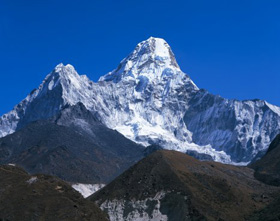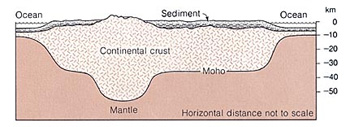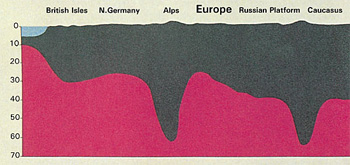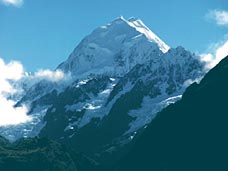The Quran on Mountains
Description: Both the Quran and science agree to the structural makeup of mountains and the role they play in maintaining the stability of the Earth.
- By islam-guide.com
- Published on 02 Mar 2006
- Last modified on 18 Sep 2020
- Printed: 2,916
- Viewed: 195,375 (daily average: 29)
- Rated by: 322
- Emailed: 175
- Commented on: 7
 A
book entitled Earth is a basic reference textbook in many universities around
the world. One of its two authors is Professor Emeritus Frank Press. He was
the Science Advisor to former US President Jimmy Carter, and for 12 years was
the President of the National Academy of Sciences, Washington, DC. His book
says that mountains have underlying roots.[1]
These roots are deeply embedded in the ground, thus, mountains have a shape
like a peg (see figures 1, 2, and 3).
A
book entitled Earth is a basic reference textbook in many universities around
the world. One of its two authors is Professor Emeritus Frank Press. He was
the Science Advisor to former US President Jimmy Carter, and for 12 years was
the President of the National Academy of Sciences, Washington, DC. His book
says that mountains have underlying roots.[1]
These roots are deeply embedded in the ground, thus, mountains have a shape
like a peg (see figures 1, 2, and 3).

Figure 1: Mountains have deep roots under the surface of the ground. (Earth, Press and Siever, p. 413.)

Figure 2: Schematic section. The mountains, like pegs, have deep roots embedded in the ground. (Anatomy of the Earth, Cailleux, p. 220.)

Figure 3: Another illustration shows how the mountains are peg-like in shape, due to their deep roots. (Earth Science, Tarbuck and Lutgens, p. 158.)
This is how the Quran has described mountains. God has said in the Quran:
“Have We not made the earth as a bed, and the mountains as pegs?” (Quran 78:6-7)
Modern earth sciences have proven that mountains have deep roots under the surface of the ground (see figure 3) and that these roots can reach several times their elevations above the surface of the ground.[2] So the most suitable word to describe mountains on the basis of this information is the word ‘peg,’ since most of a properly set peg is hidden under the surface of the ground. The history of science tells us that the theory of mountains having deep roots was introduced only in the latter half of the nineteenth century.[3]
Mountains also play an important role in stabilizing the crust of the earth.[4] They hinder the shaking of the earth. God has said in the Quran:
“And He has set firm mountains in the earth so that it would not shake with you...” (Quran 16:15)
Likewise, the modern theory of plate tectonics holds that mountains work as stabilizers for the earth. This knowledge about the role of mountains as stabilizers for the earth has just begun to be understood in the framework of plate tectonics since the late 1960’s.[5]
Could anyone during the time of the Prophet
Muhammad have known of the true shape of mountains? Could
anyone imagine that the solid massive mountain which he sees before him
actually extends deep into the earth and has a root, as scientists assert? A
large number of books of geology, when discussing mountains, only describe that
part which is above the surface of the earth. This is because these books were
not written by specialists in geology. However, modern geology has confirmed
the truth of the Quranic verses.
Could
anyone imagine that the solid massive mountain which he sees before him
actually extends deep into the earth and has a root, as scientists assert? A
large number of books of geology, when discussing mountains, only describe that
part which is above the surface of the earth. This is because these books were
not written by specialists in geology. However, modern geology has confirmed
the truth of the Quranic verses.
Footnotes:
[1]Earth, Press and Siever, p. 435. Also see Earth Science, Tarbuck and Lutgens, p. 157.
[2]The Geological Concept of Mountains in the Quran, El-Naggar, p. 5.
[3]The Geological Concept of Mountains in the Quran, p. 5.
[4]The Geological Concept of Mountains in the Quran, pp. 44-45.
[5]The Geological Concept of Mountains in the Quran, p. 5.

























